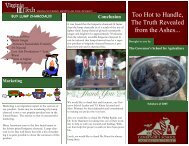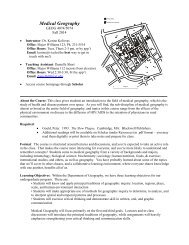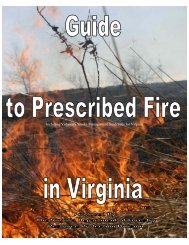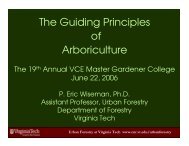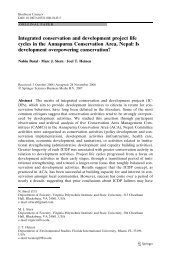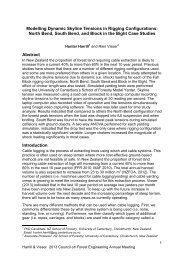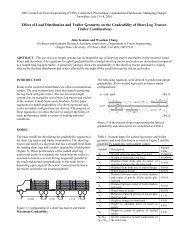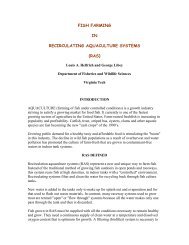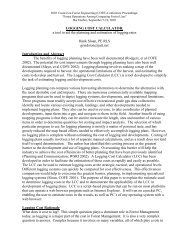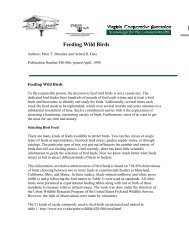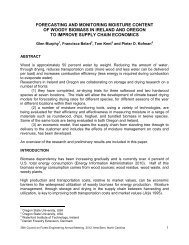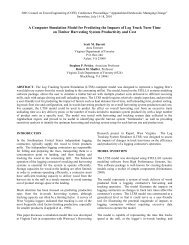1 Establishing a standard work sampling method for mastication ...
1 Establishing a standard work sampling method for mastication ...
1 Establishing a standard work sampling method for mastication ...
Create successful ePaper yourself
Turn your PDF publications into a flip-book with our unique Google optimized e-Paper software.
have strong influence on treatment cost. Cost analysis was included in this paper to serve as an<br />
example of how <strong>work</strong> <strong>sampling</strong> data can be used to calculate the operating costs of masticators.<br />
While the presented study represents a local case study, these results are valuable in the context<br />
of existing literature as the costs are within the established range and the costs of small scale<br />
machines are poorly documented.<br />
Additional research is necessary to expand the inference of this <strong>work</strong> in both <strong>work</strong> <strong>sampling</strong><br />
<strong>method</strong> establishment and the associated cost analysis. The use of different machines, both<br />
horizontal drum and rotary masticators, across a diversity of vegetation types, slope and fuel<br />
loads will allow broader use of these results by land managers and researchers.<br />
Land managers would find greater ease in evaluating fuel hazard reduction options with<br />
increased knowledge of associated costs and consistent evaluation <strong>method</strong>s. If researchers<br />
employ the <strong>standard</strong> <strong>work</strong> <strong>sampling</strong> <strong>method</strong> established here there can be valid comparison of<br />
the cost estimates produced. Valid comparison will yield greater precision in cost estimation,<br />
ultimately leading to wiser use of finite fuel hazard reduction funding and treatment of more high<br />
risk areas. The increasing number of high severity fires and their tremendous costs dictate our<br />
call to action. We must use resources wisely to maximize the amount of area treated, aiding<br />
suppression <strong>for</strong>ces in their protection of wildland resources and the wildland urban interface.<br />
References<br />
Agee, J.K. and C.N. Skinner. 2005. Basic Principles of <strong>for</strong>est fuel reduction treatments. For.<br />
Ecol. Mgmt. 211: 83-96.<br />
Bolding, M.C. 2006. An Integrated Study of Mechanical Forest Fuels Reduction: Quantifying<br />
Multiple Factors at the Stand Level. Doctor of Philosophy Dissertation. Department of<br />
Forest Engineering, Oregon State University, Corvallis, OR. 368p.<br />
Bolding, M.C. 2009. Personal communication. Assistant Professor of Forest Operations and<br />
Engineering, Virginia Tech Department of Forestry, Blacksburg, VA.<br />
Brinker, R.W., J. Kinard, B. Rummer, and B. Lan<strong>for</strong>d. 2002. Machine rates <strong>for</strong> selected <strong>for</strong>est<br />
harvesting machines. Circular 296 (revised). Alabama Agri. Exp. Sta. 29 p.<br />
Coulter, E., K. Coulter, The Yankee Group, Inc., and T. Mason, TSS Consultants. 2002. Dry<br />
Forest Mechanized Fuels Treatment Trials Project. Final Report. 92p. Available online at:<br />
www.fs.fed.us/vegtools/techniques/mechanical.shtml.<br />
Cubbage, F.1983. Economics of <strong>for</strong>est tract size: Theory and literature, U.S. DA, Forest Service<br />
Gen. Tech. Rep. SO-GTR-41. Southern Forest Experiment Station, New Orleans, LA.<br />
21p.<br />
Finney, M.A. 2001. Design of regular landscape fuel treatment patterns <strong>for</strong> modifying fire<br />
growth and behavior. For. Sci. 47(2): 219-228.<br />
Gardner, R. and P.L. Schillings. 1969. Efficiency of tree data-gathering <strong>method</strong>s <strong>for</strong> study of log<br />
making activities. USDA Forest Service Research Note INT-100. Intermountain Forest<br />
and Range Experiment Station, Ogden, UT.<br />
10



